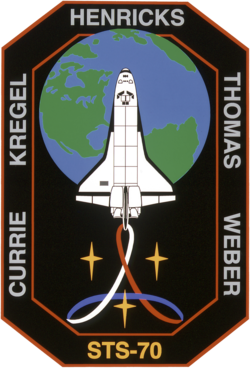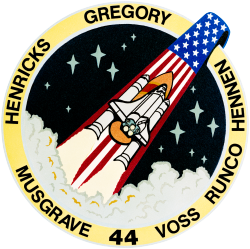Terence T. Henricks
| Terence Henricks | |
|---|---|
 | |
| Land | USA |
| Organisation | NASA |
| ausgewählt | 4. Juni 1985 (11. NASA-Gruppe) |
| Einsätze | 4 Raumflüge |
| Start des ersten Raumflugs | 24. November 1991 |
| Landung des letzten Raumflugs | 7. Juli 1996 |
| Zeit im Weltraum | 42d 18h 38min |
| ausgeschieden | 31. Oktober 1997 |
| Raumflüge | |
Terence Thomas „Tom“ Henricks (* 5. Juli 1952 in Bryan, Ohio) ist ein ehemaliger US-amerikanischer Astronaut.
Ausbildung
Henricks erhielt 1974 einen Bachelor in zivilem Maschinenbau von der United States Air Force Academy und 1982 einen Master of Public Administration von der Golden Gate University.
Militärische Laufbahn
Bei der United States Air Force absolvierte Henricks seine Ausbildung zum Piloten und später zum Testpiloten. Als Kampf- und Testpilot war er in Alabama, Florida, England, Island, Nevada und Kalifornien auf den verschiedensten Luftwaffenbasen stationiert.
Astronautentätigkeit
Im Juni 1986 wurde Henricks von der NASA als Astronautenanwärter ausgewählt. Nach seiner Ausbildung überprüfte er Shuttle-Landeplätze auf der ganzen Welt. Er arbeitete als Ingenieur für das Space-Shuttle-Programm am Johnson Space Center sowie am Kennedy Space Center.
STS-44
Am 24. November 1991 startete Henricks als Pilot der Raumfähre Atlantis zur Mission STS-44. Es war eine Mission für das US-Verteidigungsministerium. Die nicht geheime Nutzlast enthielt neben anderen militärischen Experimenten einen DSP-Satelliten und dessen Oberstufe, um den Satelliten in eine höhere Umlaufbahn zu befördern.
STS-55
Henricks zweiter Flug führte ihn als Pilot der Raumfähre Columbia ins All. Der Flug ist in Deutschland als zweite deutsche Spacelab-Mission „D-2“ bekannt. Der zehntägige Flug musste wegen verschiedener technischer Probleme mehrmals verschoben werden und konnte erst am 26. April 1993 beginnen. Bei der Mission wurde eine IMAX-Kamera mitgeführt. Mit an Bord befanden sich mit Ulrich Walter und Hans Wilhelm Schlegel zwei deutsche Astronauten.
STS-70
Am 13. Juli 1995 startete Henricks als Kommandant der Raumfähre Discovery zu seiner dritten Mission ins All. Hauptaufgabe war das Aussetzen des Relaissatelliten TDRS-G.
STS-78
Bei seinem vierten Einsatz flog Henricks am 20. Juni 1996 als Kommandant der Raumfähre Columbia (STS-78) zu dem bis dahin längsten Flug eines Space Shuttles (16d 21h 48min). Aufgabe waren Schwerelosigkeitsexperimente im Life and Microgravity Spacelab (LMS), die als Grundlage für zukünftige Experimente auf der Internationalen Raumstation (ISS) benötigt wurden.
Nach der NASA
1997 schied Henricks aus der NASA aus und wechselte zur Timken Company in Canton.
Privates
Terence Henricks ist verheiratet und hat drei Kinder.
Siehe auch
Weblinks
- Kurzbiografie von Terence T. Henricks bei spacefacts.de
- NASA-Biografie von Terence T. Henricks (englisch; PDF)
- Biografie von Terence T. Henricks in der Encyclopedia Astronautica (englisch)
| Personendaten | |
|---|---|
| NAME | Henricks, Terence T. |
| ALTERNATIVNAMEN | Henricks, Terence Thomas; Henricks, Tom (Spitzname) |
| KURZBESCHREIBUNG | US-amerikanischer Astronaut |
| GEBURTSDATUM | 5. Juli 1952 |
| GEBURTSORT | Bryan, Ohio |
Auf dieser Seite verwendete Medien
The STS-78 patch links past with present to tell the story of its mission and science through a design imbued with the strength and vitality of the 2-dimensional art of North America's northwest coast Indians. Central to the design is the space Shuttle whose bold lines and curves evoke the Indian image for the eagle, a native American symbol of power and prestige as well as the national symbol of the United States. The wings of the Shuttle suggest the wings of the eagle whose feathers, indicative of peace and friendship in Indian tradition, are captured by the U forms, a characteristic feature of Northwest coast Indian art. The nose of the Shuttle is the strong downward curve of the eagle's beak, and the Shuttle's forward windows, the eagle's eyes, represented through the tapered S forms again typical of this Indian art form. The basic black and red atoms orbiting the mission number recall the original NASA emblem while beneath, utilizing Indian ovoid forms, the major mission scientific experiment package LMS (Life and Materials Sciences) housed in the Shuttle's cargo bay is depicted in a manner reminiscent of totem-pole art. This image of a bird poised for flight, so common to Indian art, is counterpointed by an equally familiar Tsimshian Indian symbol, a pulsating sun with long hyperbolic rays, the symbol of life. Within each of these rays are now encased crystals, the products of this mission's 3 major, high-temperature materials processing furnaces. And as the sky in Indian lore is a lovely open country, home of the Sun Chief and accessible to travelers through a hole in the western horizon, so too, space is a vast and beckoning landscape for explorers launched beyond the horizon. Beneath the Tsimshian sun, the colors of the earth limb are appropriately enclosed by a red border representing life to the Northwest coast Indians. The Indian colors of red, navy blue, white, and black pervade the STS-78 path. To the right of the Shuttle-eagle, the constellation Delphinus recalls the dolphin, friend of ancient sailors and, now perhaps too, of the 9 space voyagers suggested by this constellation's blaze of 9 stars. The patch simultaneously celebrates international unity fostered by the Olympic spirit of sports competition at the 1996 Olympic Games in Atlanta, Georgia, U.S.A. Deliberately poised over the city of Atlanta, the Space Shuttle glows at its base with the 5 official Olympic rings in the 5 Olympic colors which can also be found throughout the patch, rings and colors which signify the 5 continents of the earth. This is an international mission and for the first time in NASA patch history, astronauts have dispensed with identifying country flags beneath their names to celebrate the spirit of international unity so characteristic of this flight.
STS-70 Mission Insignia
The STS-70 crew patch depicts the Space Shuttle Discovery orbiting Earth in the vast blackness of space. The primary mission of deploying a NASA Tracking and Data Relay Satellite (TDRS) is depicted by three gold stars. They represent the triad composed of spacecraft transmitting data to Earth through the TDRS system. The stylized red, white, and blue ribbon represents the American goal of linking space exploration to the advancement of all humankind.
STS-55 Mission Insignia
STS-44 Mission Insignia
Portrait des Astronauten Terence Henricks




